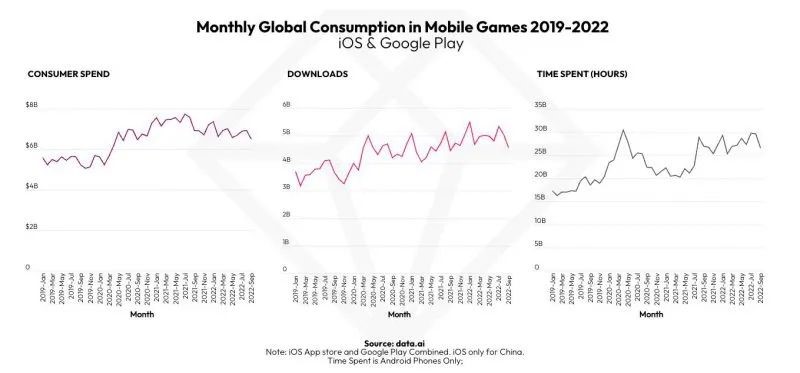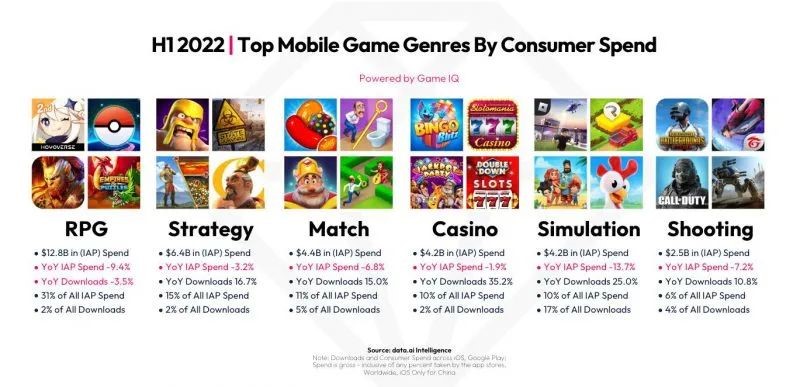Following the recovery from the COVID-19, more people are allowed to boast less time enjoying leisure time at home. In addition to the fact, the global macroeconomy without sound performance and the change of privacy policies from Apple Store and Google Play have dealt blows to the gaming industry. Recently, research institutions in the sector, including Newzoo, have lowered expectations on the annual gaming market.
Deconstructor of Fun – the well-known industry analysis blog – notes in recent days that the impact experienced by major mobile gaming categories and mobile games is analyzed and some insights are offered in the blog.
DOF believes that despite the overall impact, the time for mobile games to rank in the top 100 in terms of total revenue is narrowed down, and some categories are bucking the trend. In addition, the mobile game market will continue to retain its attractiveness. However, under the influence of the new privacy policies, each game developer needs to meet the new challenges of the industry.
The pandemic drives the mobile gaming market to record a new high in performance without lasting for a long time. As the pandemic is under good control, the engagement rate of gamers overall shows an inclining trend. However, the revenue of mobile games accounts for 61% of the game runs on all platforms, and this number is even greater if in-app advertising revenue is included.

The main challenge for mobile gaming in the last year has of course been the change in the privacy policy, thereby leading publishers to feel hard to expand their business lines on Apple Store. Another challenge that will emerge in the near future is possibly cloud gaming. As device specifications and network bandwidth keep improving, it may only be a matter of time before certain mobile game genres compete directly with PC and console platforms that offer great value through subscription services.
In the past year or so, Google Play has become the first-choice platform for testing and launching new games in that no such strict privacy policy is applied in its store. The change in privacy policy allows mobile gaming publishers to acquire technology related to adverting so as to obtain ownership of data.
The development of the mobile gaming market can be reflected in the following: the number of games launched on the market has declined for six consecutive years. While IAP sales being over $10 million with a healthy business model have steadily increased, the fact remains that the top 150 games in terms of total revenue are higher than the last 247,000 games.
In the first half of 2022, revenues for all major mobile game genres in Western markets declined though downloads continued to hike. The decrease in spending can be attributed to factors such as targeted advertising restrictions and the global economic slowdown. The continued growth in downloads lies partly in publishers seeking confidence following the launch of ATT and increased investment in the Android system.

While the market as a whole is declining, some games continue to buck the trend. These games both boast a considerable market share and increase revenue under a competitive environment, letting alone Android emulator on the cloud. As far as concerned, three strategies are offered according to the experience of the current leading players in the gaming industry.
Table of Contents
Method 1: Give Full Play to Creativity
Over the past few years, mobile gaming publishers adopt adaptive algorithms to show ads to targeted user groups. However, since the introduction of new privacy policies by platforms, publishers’ focus has shifted to a deeper understanding of the target audience, ongoing market testing, and the use of diverse marketing techniques.
All these measures are asked for publishers to analyze and master the characteristics of players. Meanwhile, testing ad material through existing marketing platforms is required to increase the number of Install Per Mille via advertising.
Method 2: Leverage IP
In the past, IP was less useful than effective marketing. But things have changed: in game development and marketing, IPs that fit the gameplay can give publishers a huge boost and drive games to attract more players.
Method 3: Focus not only on the US market and iOS platform
It is our mindset that Western countries like the United States boast the greatest market potentials. However, it seems that the cost of attracting users via ads is high. In terms of advertising, publishers should seek solutions to ensure that high investment can bring higher returns, and attempt to find a balance. Mobile gaming publishers should not focus all their attention on the U.S. market and iOS platform, but consider international markets as the rest of the countries/regions. In fact, with excellent localization ability, some publishers have successfully come to other markets and won great success.